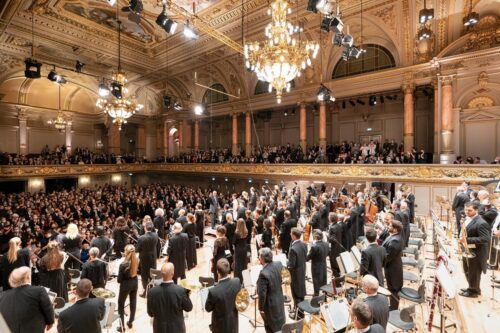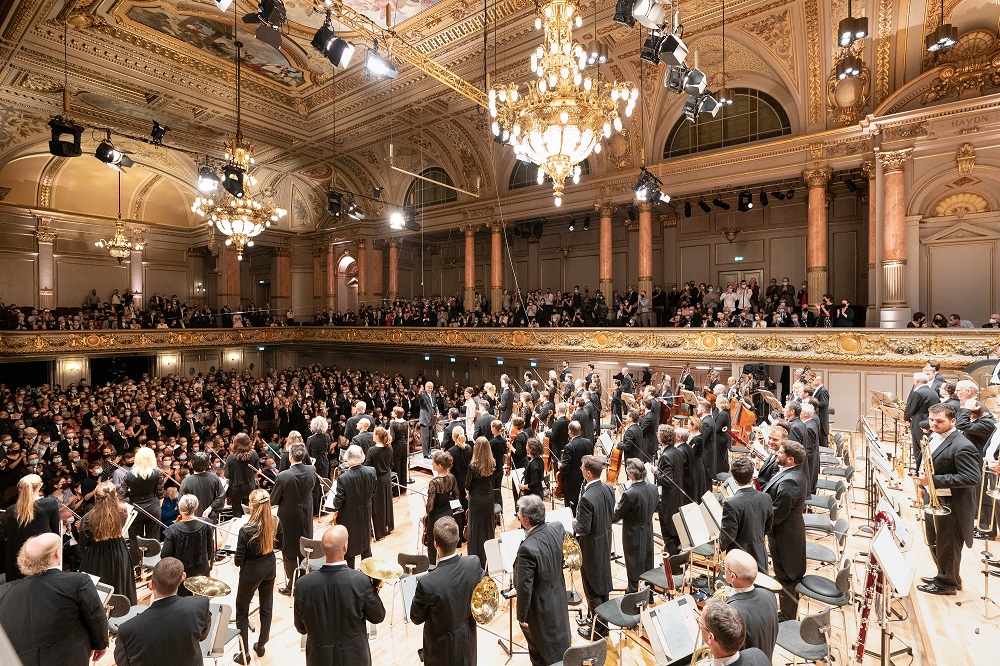 Switzerland Mahler: Wiebke Lehmkuhl (alto), Zürcher Sängerknaben (Konrad von Aarburg, Alphons von Aarburg, chorusmasters), Ladies of the Zürcher Sing-Akademie (chorusmaster Florian Helgath, Tonhalle Orchestra Zurich / Paavo Järvi (conductor). Tonhalle, Zurich, 16.9.2021. (JR)
Switzerland Mahler: Wiebke Lehmkuhl (alto), Zürcher Sängerknaben (Konrad von Aarburg, Alphons von Aarburg, chorusmasters), Ladies of the Zürcher Sing-Akademie (chorusmaster Florian Helgath, Tonhalle Orchestra Zurich / Paavo Järvi (conductor). Tonhalle, Zurich, 16.9.2021. (JR)

Mahler – Symphony No.3
Classical music lovers in Zurich and the surrounding area have been waiting patiently for four years for the Tonhalle building to be renovated (and COVID restrictions to be relaxed) and now, finally, the day has dawned. The management understandably only wanted to re-open when it was certain that a full-scale performance of a major work could be presented; with players sitting close together on stage, as in the old days, with a chorus behind them, a full house in front of them – even if the audience had to wear masks and queue to present COVID certificates on entry. This was the right time for the orchestra to present a new modern logo and a new format for their programmes. The members of the orchestra very much hope and predict, confidently, that this is the dawn of a new era for them under Paavo Järvi in their fine ‘new’ building. The Tonhalle Orchestra is now a younger orchestra, though many of its fine principals still remain.
The Tonhalle building itself was constructed in 1895, a year before Mahler composed his Third Symphony and opened with Brahms conducting his Triumphlied (not a work we now hear anything of). The hall is a classic shoebox, with 1450 seats, and generally regarded to have excellent acoustics from the outset. Its ornate interior was beginning to fade, some dusty stucco was starting to crumble, the air-cooling system was struggling, the lighting dim, backstage cramped, so renovation was required. They have taken the opportunity to tear down part of the Congress Centre next door to provide a new terrace adjoining the foyer, with spectacular views across Lake Zurich to the Alps. The colours have been refreshed, gold leaf newly applied, the huge crystal chandeliers cleaned; it all looks splendid. Acousticians were brought in to improve the sound still further and I can report they have done a fine job. The flooring has been changed; one wood floor from front to back seems to allow listeners in the Parkett (Stalls) to feel the music under their feet. When the symphony reached its many climaxes, the hall was almost vibrating. It must now be one of the world’s prettiest concert halls (lots of grey paint and pink marble), with those enviable acoustics to boot.
There was, of course, a great sense of occasion to this concert. We were welcomed with speeches by the mayor, and by the management of the orchestra. Wittily, the President of the Tonhalle Gesellschaft said this was the first time he had addressed an audience where everyone had been certified.
What better work to inaugurate this magnificent hall but Mahler’s majestic Third Symphony. It was the first symphony to be heard in the Tonhalle, in 1904. (The hall is probably not big enough to take a performance of Mahler’s Eighth). It is a unique work with six quite disparate sections.
Järvi contrasted the forceful, energetic passages with the delicate, choosing judicious dynamics and tempi throughout. He was sure-footed, as ever. Many details were highlighted, pointing to a great deal of rehearsal time having been expended.
The long first movement opens with rousing wake-up calls by eight horns echoing Brahms’s First Symphony, and immediately I experienced the improved acoustics: louder, clearer, more resonant. The principal trombone (David Bruchez-Lalli) having sadly become indisposed due to COVID shortly before the performance, co-principal Seth Quistad jumped in bravely and stole the show with a virtuoso performance in his three exposed solos.
I spotted only one minor lip-fault in the horns, but that is not unusual in a Mahler 3; overall the orchestra impressed in every section. The end of the first movement was towering; the whole audience took an audible sharp intake of breath. The ‘Flowers’ movement was gentle and joyful with string playing of the utmost delicacy. The post horn solo, evoking nostalgic melancholy, was placed in the ‘small’ Tonhalle hall, usually used for chamber concerts, behind the stalls, with ample reverberation: the effect was magical, even though a trumpet was used instead of an old valveless post horn. It was faultlessly played, by Heinz Saurer. Järvi found plenty of wit in the folksy scherzo.
Wiebke Lehmkuhl, a German alto, was utterly radiant in her exquisite rendition of ‘O Mensch! Gib Acht!’. It properly brought tears to my eyes (I don’t think it was the effect of wearing a mask). The principal oboe (Simon Fuchs) and cor anglais (Martin Frutiger) impressed with their sliding wails.
I have sung ‘Bimm Bamm’ in the London’s Royal Festival Hall (more than 50 years ago) and I was disappointed that the volume of the orchestra virtually drowned the young boys out at the beginning. There were not quite enough of them, and I am told the quality of the Lucerne Boys may be higher, but that’s a very minor quibble. The chorus of the ladies from the Zürcher Sing-Akademie were suitably angelic in ‘Es sangen drei Engel einen süssen Gesang’.
The final (slow) movement, ‘What love tells me’ gave the opportunity to the Tonhalle strings to bloom. Järvi controlled the tension to perfection. The movement, from its hushed beginnings, grew in intensity before the final wonderful brass chorale. All eyes at the end were on the two timpanists (Benjamin Forster back to play alongside Christian Hartmann) of course ensuring they were absolutely together to hammer out the symphony’s thrilling close. ‘What joy’ said my musical friend who had travelled specially from Germany to hear this performance: he had been disappointed years ago when hearing the Concertgebouw under Bernard Haitink, and his non-partisan view was that this performance was probably the finest Mahler’s Third he had ever heard. To use Herbert von Karajan’s words, the performance ‘took flight’, when some performances just do not leave the ground. High praise: and I wholly agree. I am pleased to report that the good days, musically at least, are back.
John Rhodes

Hooray!